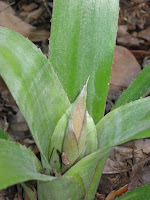Queen's Tears Bromeliad
 |
| May 2009 |
My Queen's Tears Bromeliad (Billbergia nutans) surprised me back in January when it started growing a flower stalk. These plants have always surprised me - ever since I got my first one at a plant swap at least five years ago. I see them at almost every plant swap now, so I'll bet that everyone that attends them regularly has one.
First, a little about bromeliads: They are native to South America. They are epiphytes, or "air plants", which means they have very few roots - they get most of their nutrients and water from the air. Some have suggested that they are slightly carnivorous, obtaining nutrients from insects that fall into their water-filled cups.
 |
| August 2010 |
More traditional varieties of bromeliads are sold in garden centers, usually a single rosette already in bloom in a decorative pot. Their blooms tend to be long-lasting and people will get rid of them when the blooms die. Bromeliads will bloom only once per rosette, so it is important to encourage the growth of additional rosettes.
They seem like very tropical plants, but many do well here in coastal SC given the right conditions. The first few years I had them, they went completely neglected, even to the point of letting them stay outside during our coldest nights. Despite this they survived and bloomed most years. I have since planted them in our shade garden, which gets a little morning and afternoon sun, and shade the rest of the day. Some people recommend anywhere from almost full sun to almost full shade. My experience is that mine could use a little more sun - he flower stalk seemed a little too elongated, like it was stretching for the light.
 |
| March 2011 |
Being epiphytic, they can live almost anywhere - growing on the side of a tree or planted in the ground. They have few roots, just enough to anchor them, and they get their moisture and nutrients from the air like the name suggests. They like humidity and, when it rains, their cups fill with water. If yours is in a pot, you will need to fertilize - everywhere I looked recommended a diluted, balanced, liquid fertilizer, but few mentioned foliar feeding. This may be preferable since bromeliads are epiphytes.
 |
| January 2013 |
My Queen's Tears bromeliad has bloomed at such random times of the year, that I had to look up their bloom time - any time of the year - that's what one site said, but I suspect it's usually spring through fall. I find this interesting - there are ways to force your bromeliad to bloom. One way is to add a little Epsom salt (Magnesium sulfate) to their water. The other way is probably better known, especially with other plants - place an apple next to the plant and cover both of them with a plastic bag. Leave them together for a week or more - the bromeliad should bloom within the next 1-2 months.
 |
| January 2013 |
As you can see from the photos, my bromeliad has bloomed almost every season throughout the years. I think it didn't bloom in 2012, because that's when I transplanted it into its current home, our shade garden under a giant live oak. But obviously it must like being there if it resumed blooming the next year. I hope this has given you some information about this plant, and I hope everyone will look for it at the next plant swap - I have no doubt that someone will bring one. For more information about the swap, click here. Thanks for reading!






No comments:
Post a Comment